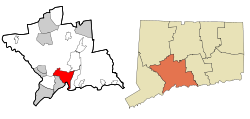**Historical Background:**
– New Haven was founded as an independent colony with a theocratic government in 1638.
– Merged with Connecticut Colony in 1664 and became co-capital in 1701.
– Yale College was established in New Haven in 1718.
– Played roles in the French and Indian War and the American Revolution.
– Industrialization began post-colonial period with inventions like the cotton gin and firearms manufacturing.
**Economy and Demographics:**
– New Haven’s economy is driven by sectors like healthcare, professional services, and retail trade.
– Home to major employers like Yale University and Southern Connecticut State University.
– Demographics include a diverse population with significant Hispanic/Latino representation.
– Household composition varies, with a mix of families, married couples, and non-families.
– Strong presence of Roman Catholicism and diverse religious institutions.
**Landmarks and Infrastructure:**
– Notable landmarks include the New Haven Green, Yale University, and cultural venues.
– Known for its nine-square grid plan and historic tree planting program.
– Ongoing infrastructure developments like the Farmington Canal Trail extension and highway projects.
– Future plans include a new boathouse, dock, and redevelopment projects in the city.
**Political Structure and Governance:**
– Governed via the mayor-council system with a Board of Alders.
– New Haven County is not a governmental entity.
– Mayor Justin Elicker leads the city, which is overwhelmingly Democratic.
– New Haven Police Department ensures public safety.
– New Haven lies within six districts of the Connecticut House of Representatives.
**Crime and Judicial System:**
– New Haven experienced a rise in crime rates post-World War II.
– Measures and programs have been implemented to address crime and improve safety.
– Collaboration between law enforcement and community organizations is emphasized.
– Judicial system includes the New Haven Judicial District Court and the New Haven Superior Court.
– Federal District Court serves the Greater New Haven area.
New Haven is a city in New Haven County, Connecticut, United States. It is located on New Haven Harbor on the northern shore of Long Island Sound and is part of the New York City metropolitan area. With a population of 135,081 as determined by the 2020 U.S. census, New Haven is the third largest city in Connecticut after Bridgeport and Stamford, the largest city in the South Central Connecticut Planning Region, and the principal municipality of Greater New Haven, which had a total population of 864,835 in 2020. Prior to 1960, it was the county seat of New Haven County until the county governments were abolished that year.
New Haven | |
|---|---|
From top, left to right: Downtown, East Rock Park, New Haven Green, Upper State Street Historic District, Five Mile Point Lighthouse, Harkness Tower, and Connecticut Hall at Yale University | |
| Nickname: The Elm City | |
| Coordinates: 41°18′36″N 72°55′25″W / 41.31000°N 72.92361°W | |
| Country | United States |
| U.S. state | Connecticut |
| County | New Haven |
| Region | South Central CT |
| MSA | Greater New Haven |
| CSA | New York |
| Settled (town) | April 3, 1638 |
| Incorporated (city) | 1784 |
| Consolidated | 1895 |
| Named for | A "New Haven", meaning "new harbor" |
| Government | |
| • Type | Mayor–board of aldermen |
| • Mayor | Justin Elicker (D) |
| Area | |
| • City | 20.13 sq mi (52.15 km2) |
| • Land | 18.69 sq mi (48.41 km2) |
| • Water | 1.44 sq mi (3.74 km2) |
| Elevation | 59 ft (18 m) |
| Population (2020) | |
| • City | 135,081 |
| • Density | 7,170/sq mi (2,768.5/km2) |
| • Urban | 561,456 (US: 77th) |
| • Urban density | 1,884.0/sq mi (727.4/km2) |
| • Metro | 862,477 (US: 69th) |
| Demonym | New Havener |
| Time zone | UTC−5 (Eastern) |
| • Summer (DST) | UTC−4 (Eastern) |
| ZIP Codes | 06501–06540 |
| Area code(s) | 203/475 |
| FIPS code | 09-52000 |
| GNIS feature ID | 0209231 |
| Airport | Tweed New Haven Airport |
| Major highways | |
| Commuter rail | |
| Website | www |
New Haven was one of the first planned cities in the U.S. A year after its founding by English Puritans in 1638, eight streets were laid out in a four-by-four grid, creating the "Nine Square Plan". The central common block is the New Haven Green, a 16-acre (6 ha) square at the center of Downtown New Haven. The Green is now a National Historic Landmark, and the "Nine Square Plan" is recognized by the American Planning Association as a National Planning Landmark.
New Haven is the home of Yale University, New Haven's biggest taxpayer and employer, and an integral part of the city's economy. Health care, professional and financial services and retail trade also contribute to the city's economic activity.
The city served as co-capital of Connecticut from 1701 until 1873, when sole governance was transferred to the more centrally located city of Hartford. New Haven has since billed itself as the "Cultural Capital of Connecticut" for its supply of established theaters, museums, and music venues. New Haven had the first public tree planting program in the U.S., producing a canopy of mature trees (including some large elms) that gave the city the nickname "The Elm City".















